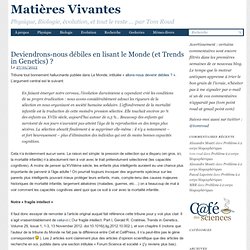

Interpréter la diversité humaine. Biologiste moléculaire, directeur de recherches émérite au CNRS, Bertrand Jordan a centré sa carrière scientifique sur la génétique humaine et l’exploration du génome, ayant notamment examiné le rôle de celui-ci dans l’autisme (Autisme, le gène introuvable.
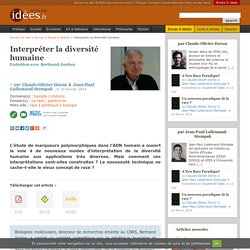
De la science au business, Seuil, 2012). On trouvera toutes les notes complétant cet entretien dans le PDF joint. Prise de vue et montage : A. Suhamy La vie des idées : Grand vulgarisateur des recherches actuelles sur les polymorphismes humains sur lesquelles vous avez notamment publié L’humanité au pluriel : la génétique et la question des races (Seuil, 2008), vous n’êtes pas vous-même praticien de ce champ. Bertrand Jordan : J’ai en effet commencé par faire une thèse en physique des particules, mais je me suis tourné vers la biologie moléculaire dès le milieu des années 1960, en raison des types très différents de recherches que ces deux domaines impliquaient. À l’époque, c’était le début du développement de la biologie moléculaire.
Nature et culture. The Many Mysteries of Neanderthals. Editor's Note: This is Part 6 in a 10-part LiveScience series on the origin, evolution and future of the human species and the mysteries that remain to be solved.

We are currently the only human species alive, but as recently as maybe 24,000 years ago another one walked the earth — the Neanderthals. These extinct humans were the closest relatives we had, and tantalizing new hints from researchers suggest that we might have been intimately close indeed. The mystery of whether Neanderthals and us had sex might possibly get solved if the entire Neanderthal genome is reported soon as expected. The matter of why they died and we succeeded, however, remains an open question.
Maybe not nasty and brutish, but still short First recognized in the Neander Valley in Germany in 1856, Neanderthals revealed that modern humans possess a rich and complex family tree that includes now-extinct relatives. They were probably less brutish and more like modern humans than commonly portrayed. Ardipithecus FAQ. Today is Ardipithecus day.
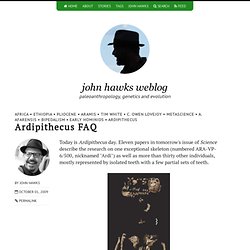
Eleven papers in tomorrow's issue of Science describe the research on one exceptional skeleton (numbered ARA-VP-6/500, nicknamed "Ardi") as well as more than thirty other individuals, mostly represented by isolated teeth with a few partial sets of teeth. I have a lot of material to share about these papers and how they change things in paleoanthropology – so much that I can't possibly fit it all into one post.
So I'm starting out with a basic overview of the main points, organized as an FAQ. Over the next few days I'll be exploring some of the most central issues in closer detail: in particular, I expect I'll be posting a new story every day for the next week or so. I will also have a short article coming out in Seed sometime this week, I will post a link when that is up. I will be editing this post recurrently – I've been speed-writing for the last couple of days and so I have some work yet to do on adding references, fixing typos, rephrasing, etc. The Future of Evolution: What Will We Become? Editor's Note: This is the last in a 10-part LiveScience series on the origin, evolution and future of the human species and the mysteries that remain to be solved.
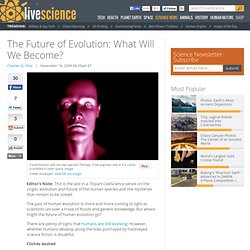
The past of human evolution is more and more coming to light as scientists uncover a trove of fossils and genetic knowledge. But where might the future of human evolution go? There are plenty of signs that humans are still evolving. However, whether humans develop along the lines portrayed by hackneyed science fiction is doubtful. Clichés dashed An old cliché has the highly evolved humans of the future sporting large heads to hold their advanced enlarged brains, "but that's nonsense, whole nonsense," said paleontologist Peter Ward at the University of Washington at Seattle, author of "Future Evolution. " Another idea, suggested by evolutionary theorist Oliver Curry of the London School of Economics, seems like a retread of ideas from science fiction writer H.G. "That's crap," Ward said. Genetic engineering The final frontier. Humans Still Evolving as Our Brains Shrink.
Editor's Note: This is Part 9 in a 10-part LiveScience series on the origin, evolution and future of the human species and the mysteries that remain to be solved.
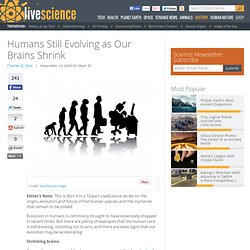
Evolution in humans is commonly thought to have essentially stopped in recent times. But there are plenty of examples that the human race is still evolving, including our brains, and there are even signs that our evolution may be accelerating. Shrinking brains Comprehensive scans of the human genome reveal that hundreds of our genes show evidence of changes during the past 10,000 years of human evolution. "We know the brain has been evolving in human populations quite recently," said paleoanthropologist John Hawks at the University of Wisconsin at Madison.
Surprisingly, based on skull measurements, the human brain appears to have been shrinking over the last 5,000 or so years. Deviendrons-nous débiles en lisant le Monde (et Trends in Genetics) ? Tribune tout bonnement hallucinante publiée dans Le Monde, intitulée « allons-nous devenir débiles ?
